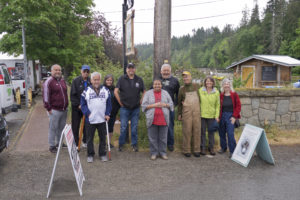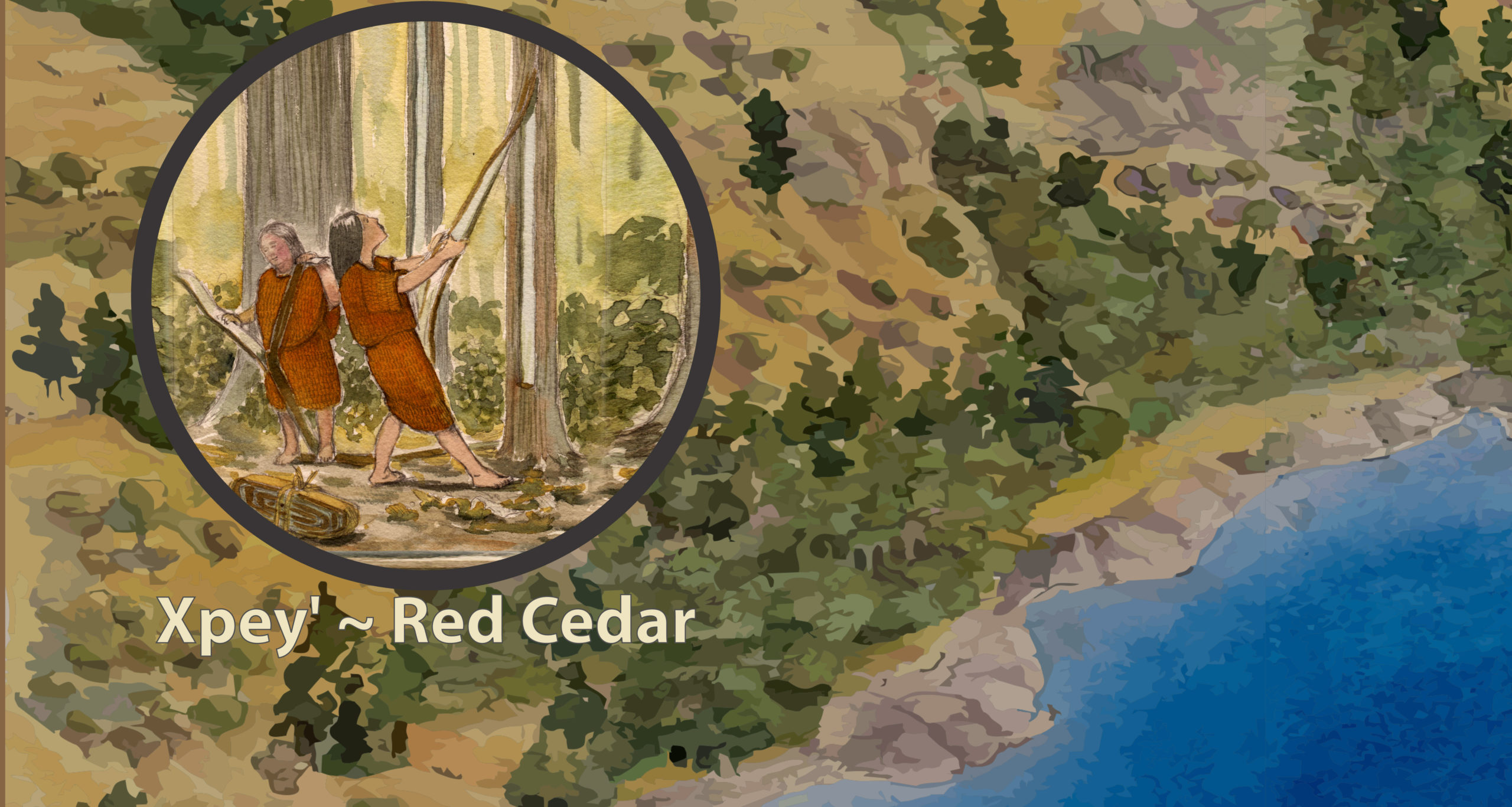The names that local First Nations gave to significant Salt Spring landmarks will soon be better known to the settler community with two complementary projects now underway.
Information panels and signage are being developed for Ganges, Fernwood and the Burgoyne Bay area — a place that has already become familiar to many islanders as Xwaaqw’um thanks to ongoing cultural reclamation work by the Stqeeye’ Learning Society. Penelakut First Nation is informing creation of the Fernwood panel, which is being produced by the new Donna Martin Legacy Fund in partnership with the Salt Spring Archives and will be designed by Phil Vernon. A third panel site is planned near Ganges Alley.
Stqeeye’ Learning Society spokesperson Joe Akerman explained the Xwaaqw’um signage project has been in development for three years and will likely be ready for public viewing in August. The cedar panels will show Hul’q’umi’num’ words and information describing important information and resources in the former Xwaaqw’um village area around Burgoyne Bay.
“It will give visitors a better sense of place and honour the ancestors the Cowichan and Coast Salish people that continue to use the land, despite continuing challenges and lack of access and resources to do so,” Akerman said.
Akerman said the three-year journey was needed to ensure the information and the interpretation were correct. The society didn’t want to just create the material in English and then ask someone to translate it. Content came “through the leadership of Tousilum, Sulsameethl and other Cowichan leaders and knowledge keepers” as part of the larger Bringing Home the Elders project.
“We’ve also been working closely with some of the few Hul’q’umi’num’ speakers left in Cowichan, including T’uwahiye’ (Philomena Williams) and Merle Seymour (Tth’ulsul-t-hw),” Akerman said.
Akerman worked closedly with the Elders and language speakers and with Vernon to design panels that feature striking Coast Salish designs by Cowichan artist Stuart Pagaduan and watercolours illustrating traditional harvesting activities by Salt Spring’s Briony Penn.
Collaboration between the Salt Spring Historical Society/ Salt Spring Archives and local First Nations for the Interpretive Panels Project in Ganges began after a presentation by elders at the Salt Spring Public Library in January 2018 inspired the organization to act. The Salt Spring Island Foundation and the Capital Regional District provided grants toward Phase One of the project: consultations with local First Nations. The working group consulted with members of both the historic Cowichan Nations and the WSÁNEC Language Advisory Group, as well as the Penelakut elders. Tousilum and Sulsameethl from Cowichan also looked at the Ganges sites and gave recommendations.

“These meetings have resulted in meaningful relationship building and have helped greatly to bridge our knowledge gap,” said Salt Spring Archives project coordinator Christina Marshall. “At present the archives has little specifi c First Nations history except for what has been recorded by the pioneers and settlers. Transcripts and other material gathered for the signage project will be added to the archive, as deemed appropriate by the First Nations involved.”
Ganges sites have been approved thanks to Ganges Alley property owner David Grayson and the CRD. The working group is putting forward a request to the CRD parks commission for placement at Fernwood. Funding to actually create the Ganges panels and the expansion of the project to include Fernwood comes through the newly created Donna Martin Legacy Fund.
Martin died earlier this year after a short battle with glioblastoma (an aggressive brain cancer). Her daughter Tara Martin, who grew up on Walker Hook and is a professor of conservation science at the University of British Columbia, said creating the $10,000 fund was one way to find closure after her mother’s death, since pandemic rules made it impossible to hold a celebration of life. The Indigenous Panel Project also fits perfectly with Donna’s ideals.
“Donna was really passionate about supporting building Indigenous relationships and supporting the resurgence of Indigenous rights and culture in the islands, and she really saw that that needed to happen in tandem with conservation,” Martin said. “She was a hard-core conservationist, and she really recognized those things go hand in hand.”
Martin described an ongoing relationship between her mother and the Penelakut people that began through shared activism about a development on Walker Hook that proposed to cut right through archaeological sites. Their relationship only strengthened through the years with events like the campaign to protect Grace Islet burial sites.
Marshall said the historical society is very happy to gain the partnership.
“Penelakut elders have already visited the Fernwood site and are very enthusiastic about the ongoing collaborative process that we are committed to,” she reported.
Vernon is the senior designer of the Ganges and Fernwood panels as well as the project’s First Nations liaison. He is building on his ongoing relationships with local Indigenous groups and employing extensive work experience in sharing and presenting sensitive cultural information. His commitment to process means continuous consultation and implementing the feedback returned for additional rounds.
“Because of the work I’ve done over the years there’s a trust that’s built up, and we’re getting conversations that go to a deeper level because of that trust. Then there’s the responsibility of bringing the information forward properly. It’s a burden we take very seriously,” Vernon said.
The Donna Martin Legacy Fund is being supported by a GoFundMe campaign. Donations can also be made by cheque or directly to an Island Savings account. See the online campaign site for more information. Martin said there will be money left over after the Fernwood and Ganges panels are completed, which could go toward the Xwaaqw’um project or other similar ventures.
“Donna Martin was a shining example of prioritizing relationships and support of local Indigenous elders and families,” Akerman said.
Partners in the Indigenous signage projects recognize their work is important but just the first step in the much bigger project of reconciliation.
“First Nations are grappling with huge issues daily and educational signage such as what we’re proposing is just a small but respectful piece of much larger ongoing work,” Marshall said.
“It’s a nice entry point, but we want to go much deeper into welcoming Coast Salish people back home,” Akerman added, noting the Stqeeye’ Learning Society has been advocating to BC Parks for the past five years to bring Cowichan Hereditary Chief and elder Tousilum home to Xwaaqw’um.
Stqeeye’ Learning Society says its work requires an elder in residence at Xwaaqw’um for direct oversight and support of its cultural plan, including continual advising and curriculum enhancement work with the Gulf Islands and Cowichan school districts, along with continuing partnerships with BC Parks and BC Wildlife Federation wetlands restoration, salmon, trout and stream monitoring, future native plant nurseries, and infrastructure improvements and maintenance. Current planning involves research and concept designs for a cultural centre at Xwaaqw’um to better host Cowichan people — adults, kids, youth and elders — and the general public.
“Elders currently travel from the Cowichan Valley to Salt Spring Island regularly, which is not sustainable physically and financially. The core goal of Stqeeye’ Learning Society is to provide opportunities for Indigenous youth to continue to re-engage with local culture and ways of life that have been forcibly removed from Indigenous communities, and educate the broader community about these ways,” Akerman said.
Donations can be made to aid the Stqeeye’ Learning Society projects at www.xwaaqwum.com. Look for more information on the society’s work in the coming months.


Hello guys, I am an Indian Tribal from eastern-most part of India. We do have a salt spring/ well production traditions which were practised by our forefathers. Now we have abandoned it. It was nice knowing that you people had also practiced once. Let’s keep in touch for further academic discourse. Regards